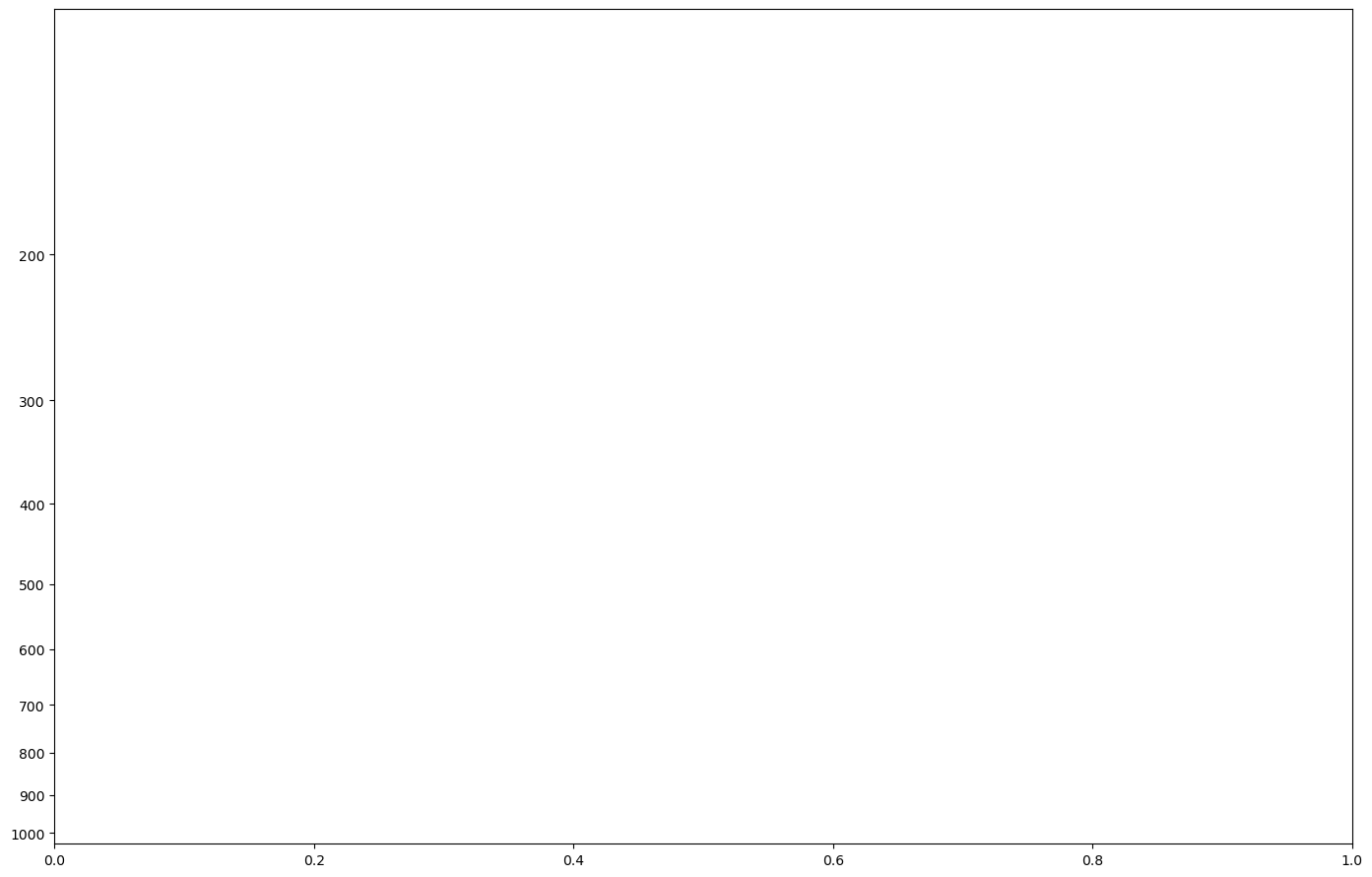Real Data Cross-Section Example
Cross-section using real data from soundings.
This example uses actual soundings to create a cross-section. There are
two functions defined to help interpolate radiosonde observations, which
won’t all be at the same level, to a standard grid. The vertical
interpolation assumes a log-linear relationship. Each radisosonde
vertical profile is interpolated first, then the
scipy.interpolate.griddata function is used to generate a full 2D
(x, p) grid between each station. Pyproj is used to calculate the
distance between each station and the standard atmosphere is used to
convert the elevation of each station to a pressure value for plotting
purposes.
from datetime import datetime
import matplotlib.pyplot as plt
import metpy.calc as mpcalc
from metpy.units import units
import numpy as np
from siphon.simplewebservice.wyoming import WyomingUpperAir
Vertical Interpolation Function
Function interpolates to given pressure level data to set grid.
def vertical_interpolate(vcoord_data, interp_var, interp_levels):
"""A function to interpolate sounding data from each station to
every millibar. Assumes a log-linear relationship.
Input
-----
vcoord_data : A 1D array of vertical level values (e.g., pressure from a radiosonde)
interp_var : A 1D array of the variable to be interpolated to all pressure levels
vcoord_interp_levels : A 1D array containing veritcal levels to interpolate to
Return
------
interp_data : A 1D array that contains the interpolated variable on the interp_levels
"""
# Make veritcal coordinate data and grid level log variables
lnp = np.log(vcoord_data)
lnp_intervals = np.log(interp_levels)
# Use numpy to interpolate from observed levels to grid levels
interp_data = np.interp(lnp_intervals[::-1], lnp[::-1], interp_var[::-1])[::-1]
# Mask for missing data (generally only near the surface)
mask_low = interp_levels > vcoord_data[0]
mask_high = interp_levels < vcoord_data[-1]
interp_data[mask_low] = interp_var[0]
interp_data[mask_high] = interp_var[-1]
return interp_data
Radiosonde Observation Interpolation Function
This function interpolates given radiosonde data into a 2D array for all meteorological variables given in dataframe. Returns a dictionary that will have requesite data for plotting a cross section.
def radiosonde_cross_section(stns, data, start=1000, end=100, step=10):
"""This function takes a list of radiosonde observation sites with a
dictionary of Pandas Dataframes with the requesite data for each station.
Input
-----
stns : List of statition three-letter identifiers
data : A dictionary of Pandas Dataframes containing the radiosonde observations
for the stations
start : interpolation start value, optional (default = 1000 hPa)
end : Interpolation end value, optional (default = 100 hPa)
step : Interpolation interval, option (default = 10 hPa)
Return
------
cross_section : A dictionary that contains the following variables
grid_data : An interpolated grid with 100 points between the first and last station,
with the corresponding number of vertical points based on start, end, and interval
(default is 90)
obs_distance : An array of distances between each radiosonde observation location
x_grid : A 2D array of horizontal direction grid points
p_grid : A 2D array of vertical pressure levels
ground_elevation : A representation of the terrain between radiosonde observation sites
based on the elevation of each station converted to pressure using the standard
atmosphere
"""
from pyproj import Geod
from scipy.interpolate import griddata
data_units = {'pressure': 'hPa',
'height': 'meter',
'temperature': 'degC',
'dewpoint': 'degC',
'direction': 'degrees',
'speed': 'knot',
'u_wind': 'knot',
'v_wind': 'knot',
'station': None,
'station_number': None,
'time': None,
'latitude': 'degrees',
'longitude': 'degrees',
'elevation': 'meter',
'pw': 'millimeter'}
# Set up vertical grid, largest value first (high pressure nearest surface)
vertical_levels = np.arange(start, end-1, -step) * units(data_units['pressure'])
# Number of vertical levels and stations
plevs = len(vertical_levels)
nstns = len(stns)
# Create dictionary of interpolated values and include neccsary attribute data
# including lat, lon, and elevation of each station
lats = []
lons = []
elev = []
keys = data[stns[0]].keys()[:8]
tmp_grid = dict.fromkeys(keys)
# Interpolate all variables for each radiosonde observation
# Temperature, Dewpoint, U-wind, V-wind
for key in tmp_grid.keys():
tmp_grid[key] = np.empty((nstns, plevs))
for station, loc in zip(stns, range(nstns)):
if key == 'pressure':
lats.append(data[station].latitude[0])
lons.append(data[station].longitude[0])
elev.append(data[station].elevation[0])
tmp_grid[key][loc, :] = vertical_levels
else:
tmp_grid[key][loc, :] = vertical_interpolate(
data[station]['pressure'].values, data[station][key].values,
vertical_levels.m)
# Compute distance between each station using Pyproj
g = Geod(ellps='sphere')
_, _, dist = g.inv(nstns*[lons[0]], nstns*[lats[0]], lons[:], lats[:])
# Compute sudo ground elevation in pressure from standard atmsophere and the elevation
# of each station
ground_elevation = mpcalc.height_to_pressure_std(np.array(elev) * units('meters'))
# Set up grid for 2D interpolation
grid = dict.fromkeys(keys)
x = np.linspace(dist[0], dist[-1], 100)
nx = len(x)
pp, xx = np.meshgrid(vertical_levels.m, x)
pdist, ddist = np.meshgrid(vertical_levels.m, dist)
# Interpolate to 2D grid using scipy.interpolate.griddata
for key in grid.keys():
grid[key] = np.empty((nx, plevs)) * units(data_units[key])
grid[key][:] = griddata((ddist.flatten(), pdist.flatten()),
tmp_grid[key][:].flatten(),
(xx, pp),
method='cubic') * units(data_units[key])
# Gather needed data in dictionary for return
cross_section = {'grid_data': grid, 'obs_distance': dist * units.meter,
'x_grid': xx * units.meter, 'p_grid': pp * units.hPa, 'elevation': ground_elevation}
return cross_section
Stations and Time
Select cross section stations by creating a list of three-letter identifiers and choose a date by creating a datetime object
# A roughly east-west cross section
stn_list = ['DNR', 'LBF', 'OAX', 'DVN', 'DTX', 'BUF']
# Set a date and hour of your choosing
date = datetime(2019, 6, 1, 0)
Get Radiosonde Data
This example is built around the data from the University of Wyoming sounding archive and using the Siphon package to remotely access that data.
# Set up empty dictionary to fill with Wyoming Sounding data
df = {}
# Loop over stations to get data and put into dictionary
for station in stn_list:
df[station] = WyomingUpperAir.request_data(date, station)
---------------------------------------------------------------------------
HTTPError Traceback (most recent call last)
Cell In[5], line 6
4 # Loop over stations to get data and put into dictionary
5 for station in stn_list:
----> 6 df[station] = WyomingUpperAir.request_data(date, station)
File ~/miniconda3/envs/cookbook-dev/lib/python3.10/site-packages/siphon/simplewebservice/wyoming.py:50, in WyomingUpperAir.request_data(cls, time, site_id, **kwargs)
30 r"""Retrieve upper air observations from the Wyoming archive.
31
32 Parameters
(...)
47
48 """
49 endpoint = cls()
---> 50 df = endpoint._get_data(time, site_id)
51 return df
File ~/miniconda3/envs/cookbook-dev/lib/python3.10/site-packages/siphon/simplewebservice/wyoming.py:70, in WyomingUpperAir._get_data(self, time, site_id)
53 def _get_data(self, time, site_id):
54 r"""Download and parse upper air observations from an online archive.
55
56 Parameters
(...)
68
69 """
---> 70 raw_data = self._get_data_raw(time, site_id)
71 soup = BeautifulSoup(raw_data, 'html.parser')
72 tabular_data = StringIO(soup.find_all('pre')[0].contents[0])
File ~/miniconda3/envs/cookbook-dev/lib/python3.10/site-packages/siphon/simplewebservice/wyoming.py:144, in WyomingUpperAir._get_data_raw(self, time, site_id)
126 """Download data from the University of Wyoming's upper air archive.
127
128 Parameters
(...)
138
139 """
140 path = ('?region=naconf&TYPE=TEXT%3ALIST'
141 '&YEAR={time:%Y}&MONTH={time:%m}&FROM={time:%d%H}&TO={time:%d%H}'
142 '&STNM={stid}').format(time=time, stid=site_id)
--> 144 resp = self.get_path(path)
145 # See if the return is valid, but has no data
146 if resp.text.find("Can't") != -1:
File ~/miniconda3/envs/cookbook-dev/lib/python3.10/site-packages/siphon/http_util.py:457, in HTTPEndPoint.get_path(self, path, query)
434 def get_path(self, path, query=None):
435 """Make a GET request, optionally including a query, to a relative path.
436
437 The path of the request includes a path on top of the base URL
(...)
455
456 """
--> 457 return self.get(self.url_path(path), query)
File ~/miniconda3/envs/cookbook-dev/lib/python3.10/site-packages/siphon/http_util.py:492, in HTTPEndPoint.get(self, path, params)
490 else:
491 text = resp.text
--> 492 raise requests.HTTPError('Error accessing {0}\n'
493 'Server Error ({1:d}: {2})'.format(resp.request.url,
494 resp.status_code,
495 text))
496 return resp
HTTPError: Error accessing http://weather.uwyo.edu/cgi-bin/sounding/?region=naconf&TYPE=TEXT%3ALIST&YEAR=2019&MONTH=06&FROM=0100&TO=0100&STNM=DNR
Server Error (503: Sorry, the server is too busy to process your request.
Please try again later.
)
Create Interpolated fields
Use the function radisonde_cross_section to generate the 2D grid (x,
p) for all radiosonde variables including, Temperature, Dewpoint,
u-component of the wind, and v-component of the wind.
xsect = radiosonde_cross_section(stn_list, df)
---------------------------------------------------------------------------
KeyError Traceback (most recent call last)
Cell In[6], line 1
----> 1 xsect = radiosonde_cross_section(stn_list, df)
Cell In[3], line 59, in radiosonde_cross_section(stns, data, start, end, step)
57 lons = []
58 elev = []
---> 59 keys = data[stns[0]].keys()[:8]
60 tmp_grid = dict.fromkeys(keys)
62 # Interpolate all variables for each radiosonde observation
63 # Temperature, Dewpoint, U-wind, V-wind
KeyError: 'DNR'
Calculate Variables for Plotting
Use MetPy to calculate common variables for plotting a cross section, specifically potential temperature and mixing ratio
potemp = mpcalc.potential_temperature(
xsect['p_grid'], xsect['grid_data']['temperature'])
relhum = mpcalc.relative_humidity_from_dewpoint(
xsect['grid_data']['temperature'],
xsect['grid_data']['dewpoint'])
mixrat = mpcalc.mixing_ratio_from_relative_humidity(xsect['p_grid'],
xsect['grid_data']['temperature'],
relhum)
---------------------------------------------------------------------------
NameError Traceback (most recent call last)
Cell In[7], line 2
1 potemp = mpcalc.potential_temperature(
----> 2 xsect['p_grid'], xsect['grid_data']['temperature'])
4 relhum = mpcalc.relative_humidity_from_dewpoint(
5 xsect['grid_data']['temperature'],
6 xsect['grid_data']['dewpoint'])
8 mixrat = mpcalc.mixing_ratio_from_relative_humidity(xsect['p_grid'],
9 xsect['grid_data']['temperature'],
10 relhum)
NameError: name 'xsect' is not defined
Plot Cross Section
Use standard Matplotlib to plot the now 2D cross section grid using the data from xsect and those calculated above. Additionally, the actualy radiosonde wind observations are plotted as barbs on this plot.
# Start Figure, set big size for cross section
fig = plt.figure(figsize=(17, 11))
# Specify plotting axis (single panel)
ax = plt.subplot(111)
# Set y-scale to be log since pressure decreases exponentially with height
ax.set_yscale('log')
# Set limits, tickmarks, and ticklabels for y-axis
ax.set_ylim([1030, 101])
ax.set_yticks(range(1000, 101, -100))
ax.set_yticklabels(range(1000, 101, -100))
# Invert the y-axis since pressure decreases with increasing height
ax.yaxis_inverted()
# Plot the sudo elevation on the cross section
ax.fill_between(xsect['obs_distance'], xsect['elevation'].m, 1030,
where=xsect['elevation'].m <= 1030, facecolor='lightgrey',
interpolate=True, zorder=10)
# Don't plot xticks
plt.xticks([], [])
# Plot wind barbs for each sounding location
for stn, stn_name in zip(range(len(stn_list)), stn_list):
ax.axvline(xsect['obs_distance'][stn], ymin=0, ymax=1,
linewidth=2, color='blue', zorder=11)
ax.text(xsect['obs_distance'][stn], 1100, stn_name, ha='center', color='blue')
ax.barbs(xsect['obs_distance'][stn], df[stn_name]['pressure'][::2],
df[stn_name]['u_wind'].values[::2, None],
df[stn_name]['v_wind'].values[::2, None], zorder=15)
# Plot smoothed potential temperature grid (K)
cs = ax.contour(xsect['x_grid'], xsect['p_grid'], mpcalc.smooth_gaussian(potemp, 1),
range(0, 500, 5), colors='red')
ax.clabel(cs, fmt='%i')
# Plot smoothed mixing ratio grid (g/kg)
cs = ax.contour(xsect['x_grid'], xsect['p_grid'], mpcalc.smooth_gaussian(mixrat*1000, 2),
range(0, 41, 2), colors='tab:green', linestyles='dotted')
ax.clabel(cs, fmt='%i')
# Add some informative titles
plt.title('Cross-Section from DNR to BUF Potential Temp. '
'(K; red) and Mix. Rat. (g/kg; green)', loc='left')
plt.title(date, loc='right');
---------------------------------------------------------------------------
NameError Traceback (most recent call last)
Cell In[8], line 19
16 ax.yaxis_inverted()
18 # Plot the sudo elevation on the cross section
---> 19 ax.fill_between(xsect['obs_distance'], xsect['elevation'].m, 1030,
20 where=xsect['elevation'].m <= 1030, facecolor='lightgrey',
21 interpolate=True, zorder=10)
22 # Don't plot xticks
23 plt.xticks([], [])
NameError: name 'xsect' is not defined


